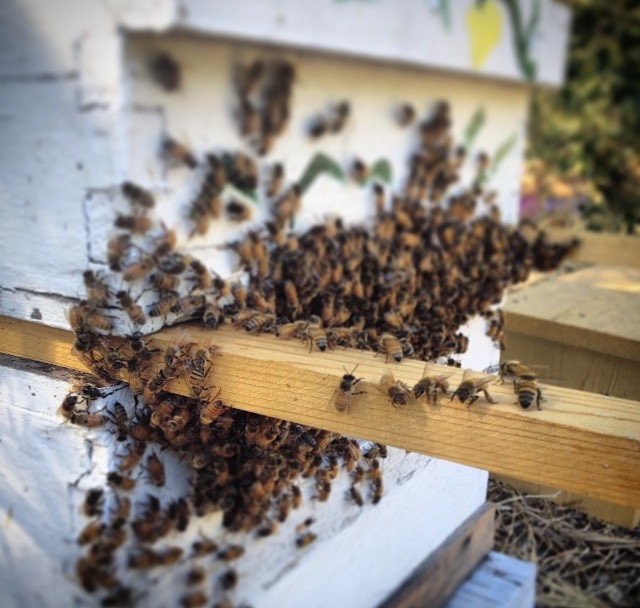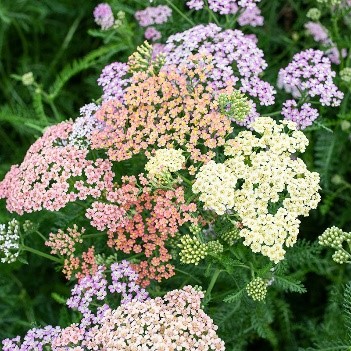
Posted on : June 4th, 2024
Introducing our “Buy for BEECause” campaign! This month, 3% of all online sales will go towards purchasing bee-friendly pollinator plants for an almond orchard, supporting the vitality of native bee species. Stay tuned for exciting Pollinator Month sales and join us in making a difference!
June is celebrated as Pollinator Month, a time dedicated to acknowledging the indispensable role that pollinators play in our ecosystems and agriculture. The celebration originated from National Pollinator Week, which was initiated by the Pollinator Partnership in 2007. Recognizing the crucial contributions of bees, butterflies, bats, and other pollinators, the U.S. Senate unanimously designated a week in June as National Pollinator Week. Over time, the observance has expanded to an entire month, providing ample opportunity to educate the public, promote pollinator-friendly practices, and celebrate these tiny, yet mighty creatures.

Bees on Bee Box
One of the best ways to support pollinators is by planting a garden filled with native plants. Choose a variety of flowers that bloom at different times of the year to provide a continuous food source. Native plants are particularly beneficial because they have evolved alongside local pollinators and provide the most suitable habitat and nutrition. Here is just a few examples…

California Poppies
California Poppy (Eschscholzia californica)
Pollinators Attracted: Bees and butterflies are particularly drawn to the bright blooms.
Growing Tips: Prefers full sun and well-drained soil. It’s drought-tolerant once established.

Blueblossom
Blueblossom (Ceanothus thyrsiflorus)
Pollinators Attracted: Bees, butterflies, and birds.

Yarrow
Growing Tips: Does well in full sun to partial shade and well-drained soil. It’s drought-tolerant and supports a range of wildlife.
Yarrow (Achillea millefolium)
Pollinators Attracted: Bees, butterflies, and beneficial insects.
Growing Tips: Prefers full sun and well-drained soil. It’s adaptable to various conditions and drought tolerant.
Another great way to celebrate is by attending or hosting workshops focused on pollinator conservation. Many organizations like UC master Gardeners of Butte County offer events and workshops that teach about the importance of pollinators. They teach how to create habitats for them. These workshops often provide hands-on experience in building bee hotels, installing pollinator gardens, and understanding the complex relationships between plants and their pollinators.

Natual Pest Control Ladybug
Reducing pesticide use is another critical action. Pesticides can be harmful to pollinators, so opting for natural pest control methods and educating others about the negative impacts of chemical pesticides can make a big difference. Natural pest control methods include using beneficial insects like ladybugs, encouraging the presence of birds that feed on pests, and applying organic solutions such as neem oil. It’s important to understand that a healthy garden ecosystem can naturally balance itself without the need for harmful chemicals.
Supporting local beekeepers by purchasing honey and other bee products helps sustain these vital pollinators. Local beekeepers often practice more sustainable methods than large-scale operations, and buying their products ensures that they can continue to support healthy bee populations. Additionally, local honey can have health benefits, such as reducing seasonal allergies. Here at Maisie Jane’s, we have our very own Honey, we take pride in our sustainable Bee practices!
California is home to over 1,600 species of native bees, including bumblebees, sweat bees, and carpenter bees. These bees have evolved to pollinate the diverse array

Monarch Butterfly Grove (Pismo Beach)
of plants found in California’s varied ecosystems, from coastal areas to deserts and mountains. The state also provides critical wintering grounds for the Western Monarch Butterfly, with places like Pismo Beach and Pacific Grove being popular overwintering sites. Monarch butterflies undertake a remarkable migration journey, traveling thousands of miles from Canada and the United States to overwinter in California and Mexico.

Bat Pollinating a agave plant.
Lesser-known pollinators, such as the Mexican free-tailed bat, play a significant role in pollinating agave plants, crucial for tequila production. These bats feed on the nectar of night-blooming flowers, transferring pollen as they move from plant to plant. Without these nocturnal pollinators, the agave plants would not be able to reproduce effectively, impacting the tequila industry.
Additionally, hummingbirds, with their vibrant colors, are effective pollinators, especially for plants with tubular flowers like the California fuchsia. Hummingbirds have long, specialized bills that allow them to access nectar deep within flowers, and as they feed, they inadvertently transfer pollen. Their rapid wing beats and hovering ability make them fascinating to watch as they go about their pollination duties.

Bee pollenating an almond Blossom
Pollinators are essential for the production of many crops in California, which is a leading agricultural state. They contribute significantly to the state’s economy by enhancing crop yields and quality. For instance, California produces 80% of the world’s almonds, and pollination by honeybees is vital for the crop’s production. Without these pollinators, almond trees would produce significantly fewer nuts, leading to lower yields and higher prices.

Berries, such as strawberries, blueberries, and raspberries, rely heavily on pollinators for fruit set and development. These fruits are not only important for their nutritional value but also contribute to the agricultural economy through fresh fruit sales, processed goods, and export markets. Vegetables like squash, cucumbers, and tomatoes also benefit from the pollination services provided by bees and other pollinators. Proper pollination can improve the size, shape, and taste of these vegetables, making them more appealing to consumers.
Furthermore, many seed crops, including alfalfa and various vegetables, require insect pollination. Alfalfa, in particular, is a crucial crop for livestock feed, and its seeds are pollinated primarily by leafcutter bees. The health of the livestock industry depends on the availability of high-quality alfalfa, highlighting the interconnectedness of pollinators and various agricultural sectors.
To promote awareness and education, various organizations in California highlight a different pollinator each month. These resources typically include information on the species’ habitat, behavior, and role in the ecosystem. The UC Berkeley Urban Bee Lab (http://www.helpabee.org/) provides detailed profiles of native bees and how to support them. Their research includes identifying the best plants for supporting native bee populations and understanding the ecological roles these bees play.

Beekeeper Showing the inside of a bee box
The Xerces Society (https://xerces.org/) offers extensive resources on pollinator conservation, including fact sheets and habitat creation guides. Their materials are designed to help individuals and communities create environments that support pollinators, from urban gardens to large-scale agricultural settings. They also provide guidance on policy advocacy and community organizing to protect pollinator habitats.
The California Native Plant Society (https://www.cnps.org/) features native plant recommendations that support local pollinators. By promoting the use of native plants, they help ensure that pollinators have access to the food and habitat they need to thrive. Their resources include plant guides, garden design tips, and information on where to buy native plants.
Creating habitat corridors by planting pollinator-friendly plants in urban and suburban areas can help

Bee Boxes in an Almond Orchard
connect fragmented habitats. This can be particularly important in highly developed regions where natural habitats have been lost. Even small patches of pollinator-friendly plants in home gardens, parks, and along roadsides can provide vital resources and pathways for pollinators to travel between larger habitat areas.
Participating in citizen science projects like the Great Sunflower Project or Monarch Watch allows individuals to contribute to pollinator research and conservation efforts. These projects often involve simple activities like counting pollinators or tracking the migration of monarch butterflies. The data collected by citizen scientists can help researchers understand pollinator populations and identify conservation priorities.
Educating and advocating for pollinator protection by working with local schools, community groups, and policymakers can promote policies that protect pollinators and their habitats. This can include advocating for reduced pesticide use, supporting habitat restoration projects, and promoting the planting of native plants in public spaces.
By celebrating Pollinator Month, we not only acknowledge the vital role these creatures play in our lives but also take steps to ensure their survival for generations to come. Every action, big or small, contributes to a healthier, more sustainable ecosystem.
So, let’s get out there and make a difference for our pollinators!
Maise Jane & Her Nutty Team!